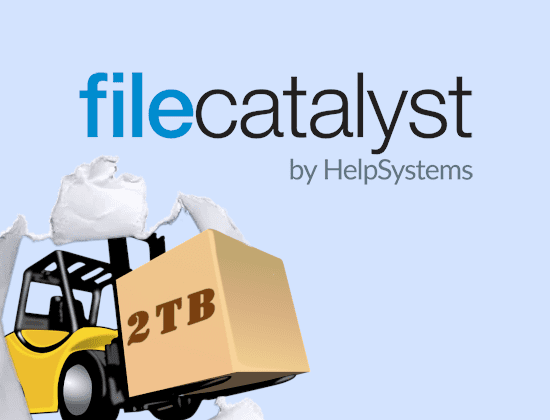Common Questions About Fast File Transfer
There is no doubt we live in an information-intensive world, one in which getting the right data quickly is often pivotal to an organization’s success. Moving files from point A to point B requires many considerations, but when it comes to large, mission-critical files that need to reach recipients around the world as fast as possible, it’s time to move beyond options such as Dropbox and Google Drive. This is where FileCatalyst’s proprietary fast file transfer capabilities come into play.
Before fast file transfer, moving time-sensitive files was a major challenge for organizations with hard deadlines, such as broadcast media, live sports, and healthcare. For example, without fast file transfer it could take a 1TB file up to 27 days to move from London to Vancouver. Many businesses simply can’t tolerate this transit time, especially with expensive resources sitting around waiting to process files. There’s ROI to be had from accelerating the exchange.
Here’s a helpful Q&A for those new to understanding this powerful capability and its benefits.
What file types are good candidates for fast file transfer?
Fast file transfer works with many types of files in different industries. It excels at transferring big data repositories by leveraging the UDP-based protocol as well as 256-bit AES and TLS encryption. This powerful tool can transfer anything, from research datasets and software updates to military intelligence and data backups, but here we’ll focus on two primary use cases: media and healthcare. Bottlenecks and delays in these industries simply aren’t acceptable because the stakes are too high.
Media: Media assets such as live sporting events, news broadcasts, movies, and advertisements have defined drop dates and massive file sizes. For big media, there is significant ROI in reducing file transfer times. Staff work around the world and shoot video that must be transferred, edited, and produced as quickly as possible. SFTP simply can’t handle this task.
Healthcare: Every second counts when patients are nervously awaiting the results of their imaging, which often includes 3D and 4D scans and bioinformatics stored in large file repositories. Images need to be uploaded for experts to interpret—and these experts may be in another country. Fast file transfer condenses the wait time for all involved, enabling provider efficiency and faster results that inform treatment plans and improve patients’ lives.
In a perfect world, how fast would files move?
FileCatalyst can achieve multi-gigabit file transfer speeds of up to 10 Gbps. But, as with most technologies, there are several variables involved with optimizing performance. File size and the geographies of the sender and receiver have an impact. Likewise, the speeds of your network and the storage components you’re reading from and writing to have a direct correlation to transfer speed.
Once these are optimized, layering on FileCatalyst fast file transfer will deliver the boost you’re looking for, utilizing 95%+ of your maximum network connection. The solution also enables you to get up and running quickly because there’s no heavy IT involvement. With no hardware to set up, the software can be installed in under 20 minutes at both ends of the transfer.cy and faster results that inform treatment plans and improve patients’ lives.
What speed impediments does FileCatalyst help users overcome?
File transfer acceleration solutions move data using custom protocols, often built on top of UDP, and in lieu of the traditional TCP method. FileCatalyst combines the reliability of TCP with the speed of UDP into a proprietary algorithm to accelerate files and increase reliability. Additionally, the FileCatalyst software development kit (SDK) enables IT teams to embed FileCatalyst into homegrown applications if you’ve developed your own MFT capabilities and need to add fast file transfer.
For those familiar with managed file transfer (MFT) solutions like GoAnywhere, the SFTP, HTTP, HTTPS, and other protocols behind the scenes leverage TCP to transfer smaller-sized files that need additional oversight and control.
What factors cause a file transfer to be slower than expected? Which ones can be controlled?
As we’ve mentioned, network infrastructure and speed will affect file transfers. You have more control over direct network connections via terrestrial links like fiber and cable. However, once you introduce wireless and mobile networks that go over the air, transfer speeds become less predictable. You may be located far away from the nearest cell tower and have more interference, which leads to packet loss and slow TCP. Likewise, some people now have 5G for their home networks instead of cable or fiber, which can slow transfers as well.
Businesses that operate on ships rely on satellite networks, which suffer latency due to over-the-air communications and packet loss because of weather interference. FileCatalyst’s optimized bandwidth usage increases reliability and speed across poor network conditions, wherever they may be, to optimize what’s available.
Throughout the file transfer process and when UDP is not possible due to network restriction, multi-stream TCP file transfer begins, which sends multiple parts of the file over multiple TCP streams. It’s even possible to restart stopped transfers automatically without starting at the beginning. Fine-grained bandwidth controls allow administrators to quickly assign more bandwidth where it’s needed, and less where it isn’t.
FileCatalyst Works with GoAnywhere MFT
If you’re looking for an advanced method of transferring large files quickly and securely, FileCatalyst is a great option. In addition, our GoAnywhere managed file transfer (MFT) solution offers integrated FileCatalyst capabilities if you need a broader platform for fast file transfers.
The latest encryption standards are employed for file security with both software solutions. In addition, both solutions offer reliability assurances with delivery restart guarantees and alerts.
Whether you need to mirror data for disaster recovery, transfer large volumes of sizeable data quickly and securely, send “live” files from remote locations, or get that patient X-ray to a technician rapidly, FileCatalyst and GoAnywhere MFT play nicely together to optimize your file transfer capabilities.
If you would like to learn more about how BlueFinch can help your organisation protect its sensitive data and about our Data Security Suite? Please contact sales@bluefinch.com and take a look at our solutions.




